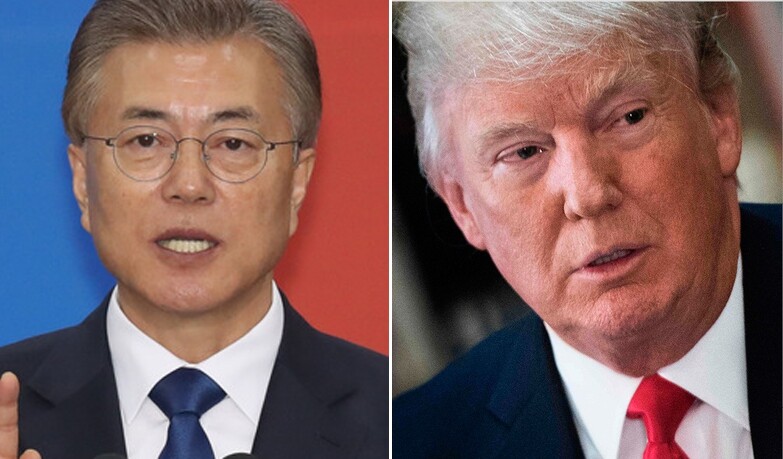hankyoreh
Links to other country sites 다른 나라 사이트 링크
[News analysis] Upcoming S. Korea-US summit first hurdle to address N. Korean nukes

President Moon Jae-in’s repeated emphasis on resolving the North Korean nuclear issue and improving relations with Pyongyang in recent interviews with the US media ahead of his June 29 summit with US President Donald Trump are focusing attention on the summit discussions that represent the first hurdle in achieving the two aims.
A list of agenda items for the summit announced by the Blue House on June 14 included both “joint ideas for a fundamental resolution to the North Korean nuclear issue” and “achieving peace on the Korean Peninsula.” South Korean and US authorities also announced four principles when affirming their common position on the North Korean nuclear issue last month: the ultimate goal should be North Korea’s complete denuclearization; every means should be used, including both sanctions and dialogue; dialogue could take place if the proper conditions are established with Pyongyang; and Seoul and Washington should work on resolute, practical joint plans to meet this goal. Moon’s remarks go a step further from this framework in fleshing out a possible solution.
The nuclear freeze that represents the first stage in the two-stage resolution plan suggested by Moon (freezes in North Korean nuclear and missile activity, followed by abandonment of the nuclear program) has a history dating back to the Agreed Framework dramatically reached by Pyongyang and Washington in Geneva at the time of the first North Korean nuclear crisis in Jan. 1994. At the time, the US agreed to provide a light-water reactor and alternative energy sources to the North in exchange for the latter freezing and ultimately dismantling its graphite-moderated reactor and related facilities. This freeze deal was also stipulated in agreements on Feb. 13, 2007, and Feb. 29, 2012.
The question is how to enter into talks toward this initial freeze stage. Some have suggested resuming operations at the Kaesong Industrial Complex and/or tourism at Mt. Keumgang could furnish a way toward reopen dialogue, but Moon has stated that a freeze in North Korea’s nuclear and missile programs “must come first.” Moon also insisted that he had “never talked about dialogue without any preconditions.”
So far, the only condition for dialogue mentioned by Moon appears to be a halt to additional North Korean nuclear and missile provocations. But some have noted that it is unclear whether “additional provocations” refers only to strategic provocations like nuclear tests and ICBM launches, or may include short-range missile launches that can occur as a regular part of North Korean military exercises.
Another possible way to resume dialogue is through a scaling down of joint South Korea-US military exercises.
“In terms of the Ulchi-Freedom Guardian [joint exercises] scheduled for August, some visible measures [by authorities to scale down the exercise] by July would be a way of preventing a possible crisis ahead of dialogue,” suggested one North Korea expert on condition of anonymity.
Experts agreed that while North Korea may continue feeling out the climate through the South Korea-US summit in late June, it could attempt intensive provocations once July begins.
In a recent interview with the Hankyoreh, former University of California, Berkeley Institute of East Asian Studies director and leading US authority on North Korea Tony Namkung said one way to resolve the North Korean nuclear issue would be through resuming bilateral North Korea-US and inter-Korean “2+2” talks. During the Lee Myung-bak administration in 2012, a series of trilateral meetings by South and North Korea and the US resulted in a Feb. 29 agreement that pledged a moratorium on nuclear activity and recognized the armistice agreement on the Korean Peninsula.
By Kim Ji-eun, staff reporter
Please direct questions or comments to [english@hani.co.kr]

Editorial・opinion
![[Column] Park Geun-hye déjà vu in Yoon Suk-yeol [Column] Park Geun-hye déjà vu in Yoon Suk-yeol](https://flexible.img.hani.co.kr/flexible/normal/500/300/imgdb/original/2024/0424/651713945113788.jpg) [Column] Park Geun-hye déjà vu in Yoon Suk-yeol
[Column] Park Geun-hye déjà vu in Yoon Suk-yeol![[Editorial] New weight of N. Korea’s nuclear threats makes dialogue all the more urgent [Editorial] New weight of N. Korea’s nuclear threats makes dialogue all the more urgent](https://flexible.img.hani.co.kr/flexible/normal/500/300/imgdb/original/2024/0424/7317139454662664.jpg) [Editorial] New weight of N. Korea’s nuclear threats makes dialogue all the more urgent
[Editorial] New weight of N. Korea’s nuclear threats makes dialogue all the more urgent- [Guest essay] The real reason Korea’s new right wants to dub Rhee a founding father
- [Column] ‘Choson’: Is it time we start referring to N. Korea in its own terms?
- [Editorial] Japan’s rewriting of history with Korea has gone too far
- [Column] The president’s questionable capacity for dialogue
- [Column] Are chaebol firms just pizza pies for families to divvy up as they please?
- [Column] Has Korea, too, crossed the Rubicon on China?
- [Correspondent’s column] In Japan’s alliance with US, echoes of its past alliances with UK
- [Editorial] Does Yoon think the Korean public is wrong?
Most viewed articles
- 1‘We must say no’: Seoul defense chief on Korean, USFK involvement in hypothetical Taiwan crisis
- 2N. Korean delegation’s trip to Iran shows how Pyongyang is leveraging ties with Moscow
- 3‘Weddingflation’ breaks the bank for Korean couples-to-be
- 4Will NewJeans end up collateral damage in internal feud at K-pop juggernaut Hybe?
- 546% of cases of violence against women in Korea perpetrated by intimate partner, study finds
- 6[Column] Park Geun-hye déjà vu in Yoon Suk-yeol
- 7“Parental care contracts” increasingly common in South Korea
- 8[Column] Yoon’s first 100 days should open our eyes to pitfalls of presidential system
- 9[Interview] Dear Korean men, It’s OK to admit you’re not always strong
- 10[Editorial] New weight of N. Korea’s nuclear threats makes dialogue all the more urgent